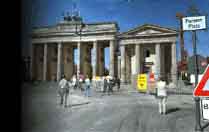(Brandenburger Tor)


| Brandenburg Gate (Brandenburger Tor) |
The Brandenburg Gate which is 65 ft. high, 213 ft. wide and 36 ft. thick was built from 1788-1791 by Karl Gotthard Langhans. It was the first classical building in Berlin and is shaped after the "Propylene" in Athens. In 1794 Johann Gottfried Schadow built the "Quadriga" on the roof of the Brandenburg Gate which is a foursome horse and cart including the goddess Eirene. The Brandenburg Gate plays a highly symbolic role in the German history. Initially, it was the western city gate. Until the emperor`s resignation, only members of the royal family and its visitors were allowed to use the middle part of the gate. In 1806 Napoleon and his troops marched into Berlin and transported the Quadriga to Paris where it was shown in the Louvre as a sign of victory. Marshall Blücher took the Quadriga back to Berlin after the victory over the French in 1814 and the peace goddess Eirene became the goddess of victory Victoria. She received the laurel wreath, the Prussian eagle and the iron cross designed by Friedrich Schinkel as a sign of victory. After the German Nazis took over, the gate became a symbol for fascist Germany. Torches in hand, the fascists marched through the gate down the avenue "Straße unter den Linden" which became Hitler's favorite parade avenue. The Quadriga had lost its character of peace for | |||
 |
||||

|
||||